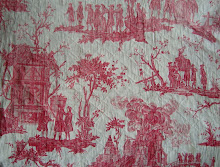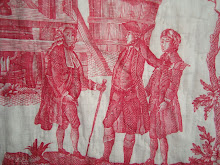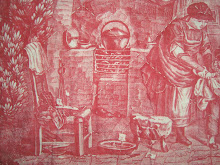






Well, I have removed almost all the layers of fabric that I can, and was expecting this to be the last post about the quilt, but it isn't to be. It has revealed a lot of information, but posed almost as many questions!
I was expecting a single mass of sheeps fleece wadding, but it turns out to be a patchwork of pieces, almost completely felted over time, pieced together into a small rectangle with linen or hemp thread. Most of the panels are edged with the remains of the indigo woven fabric discovered in part 4, which now turns out to be a colourful indigo, white, pink, yellow and maybe purple ikat woven flamme fabric, either cotton or linen, I'm not too sure. This could be quite an early fabric! If you click on each photo for the supersized pics, you may be able to see that it looks as if the ikat remains - a real shame so little remains - seem to be over-lapping the red and blue striped fabric at their edges where front and back have been sewn together, leading me to believe that this must surely be the earliest layer, with the ikat as the next layer, followed by the R&S, then the C&J. I am now of the opinion that the red and black printed floral twil was the reverese for the R&S, but outlasted the rest of the layers beacuse of its durability as a fabric. Please see the way some of the colour has bled from into the fleece from the stitchmarks, directly onto the fleece. The greenish grey floral was the penultimate layer, finally to be patched with the scruffy, faded cream cretonne.
PS. I have just looked this post to check spelling etc, and noticed something I hadn't spotted before when i checked the photos. Please look at the second to last supersize pic, does it look to you as if there is a piece of different woven fabric UNDERNEATH the red & blue layer, I had assumed the R&B to be the earliest, maybe it isn't! I shall have to investigate...
I was expecting a single mass of sheeps fleece wadding, but it turns out to be a patchwork of pieces, almost completely felted over time, pieced together into a small rectangle with linen or hemp thread. Most of the panels are edged with the remains of the indigo woven fabric discovered in part 4, which now turns out to be a colourful indigo, white, pink, yellow and maybe purple ikat woven flamme fabric, either cotton or linen, I'm not too sure. This could be quite an early fabric! If you click on each photo for the supersized pics, you may be able to see that it looks as if the ikat remains - a real shame so little remains - seem to be over-lapping the red and blue striped fabric at their edges where front and back have been sewn together, leading me to believe that this must surely be the earliest layer, with the ikat as the next layer, followed by the R&S, then the C&J. I am now of the opinion that the red and black printed floral twil was the reverese for the R&S, but outlasted the rest of the layers beacuse of its durability as a fabric. Please see the way some of the colour has bled from into the fleece from the stitchmarks, directly onto the fleece. The greenish grey floral was the penultimate layer, finally to be patched with the scruffy, faded cream cretonne.
A lot of food for thought there, 2 ideas spring to mind at this stage, please let me know what you think, and your ideas about its story!
Firstly, it could be a quilt that has been passed on through the same family as an heirloom, being re-worked and re-covered by different generations. Perhaps it started its journey in the late 1700s, early 1800s as evidenced by the woven fabrics in the centre. This would have been in use for quite some time, then, when the ikat had virtually worn away, was discarded, and eventually salvaged by being cut into panels and re-covered with 'modern, fashionable' printed cotton (R&S) on 1 side, with the heavy twill weave print for the other side sometime around the mid 1800s. A bit later, maybe around 1860-80, it was re-covered in the second printed cotton, the C&J layer, but the twill was still in good enough condition to stay in place. When the C&J wore out, the greenish grey floral was added around 1890-1900. Finally, the scruffy cream panel was applied over the worn floral as a large patch around 1920-30.
Secondly, following a similar timeline, it could have been made by a reasonably well-off woman, a Farmer's wife, for example, as a large quilt and used until the fabric wore out, then gifted to a poorer relative, or perhaps a servant, who cut it down into useable panels, sewed them into a small quilt shape and recovered it. It was then kept and rennovated, until it was eventually discarded and ended up in the abondoned rag store in the 1950s, which is where it was discovered by the woman I bought it from.
Of course, these are just theories and ideas, but the 'story' of this little quilt begs to told in some way. We shall never really know, but it is fun to try to 'deduce' a cultural context for it!
Now that I have removed most of the fabric, a few last things need to be looked at for the next post, I need to strip out some of the red & blue woven stripe, and see if it is the central, or earliest layer, and I shall try out a burn test on the woven striped pabrics to try to ascertain what type of fabric they are made from, wool, cotton, linen etc. Your comments and ideas would be greatly appreciated!
Firstly, it could be a quilt that has been passed on through the same family as an heirloom, being re-worked and re-covered by different generations. Perhaps it started its journey in the late 1700s, early 1800s as evidenced by the woven fabrics in the centre. This would have been in use for quite some time, then, when the ikat had virtually worn away, was discarded, and eventually salvaged by being cut into panels and re-covered with 'modern, fashionable' printed cotton (R&S) on 1 side, with the heavy twill weave print for the other side sometime around the mid 1800s. A bit later, maybe around 1860-80, it was re-covered in the second printed cotton, the C&J layer, but the twill was still in good enough condition to stay in place. When the C&J wore out, the greenish grey floral was added around 1890-1900. Finally, the scruffy cream panel was applied over the worn floral as a large patch around 1920-30.
Secondly, following a similar timeline, it could have been made by a reasonably well-off woman, a Farmer's wife, for example, as a large quilt and used until the fabric wore out, then gifted to a poorer relative, or perhaps a servant, who cut it down into useable panels, sewed them into a small quilt shape and recovered it. It was then kept and rennovated, until it was eventually discarded and ended up in the abondoned rag store in the 1950s, which is where it was discovered by the woman I bought it from.
Of course, these are just theories and ideas, but the 'story' of this little quilt begs to told in some way. We shall never really know, but it is fun to try to 'deduce' a cultural context for it!
Now that I have removed most of the fabric, a few last things need to be looked at for the next post, I need to strip out some of the red & blue woven stripe, and see if it is the central, or earliest layer, and I shall try out a burn test on the woven striped pabrics to try to ascertain what type of fabric they are made from, wool, cotton, linen etc. Your comments and ideas would be greatly appreciated!
PS. I have just looked this post to check spelling etc, and noticed something I hadn't spotted before when i checked the photos. Please look at the second to last supersize pic, does it look to you as if there is a piece of different woven fabric UNDERNEATH the red & blue layer, I had assumed the R&B to be the earliest, maybe it isn't! I shall have to investigate...



















































































I am not sure where to even begin. This journey is so amazing, almost as if the quilt were communicating to you. All the way through I am thinking about how we deal with things like this today. We throw away! And isn't this so sad? Look at the wealth of history you are unveiling. I am sure it was a treasured quilt and perhaps one that had many life experiences that made it even more special and worthy to family members. If only we really knew, but I truly believe it was an heirloom passed down for many generations.
ReplyDeleteA few questions...I am not sure what the "penultimate"layer is. Did I miss something a few posts back? Also I think it fascinating the dates you are coming up with and what research books are you using because your knowledge is very impressive? Also, I know how to test for natural fibers versus synthetic, but what is your calculation for differentiating wool from cotton from linen, etc. What an absolute feast of textile history you are excavating. This has been so much fun to watch and learn and explore. I think you should document this to some quilt study group in your area. Thank you for all the hard work as well as the great photos of this process.
Hi Phyllis, wonderful to hear from you as always! The 'penultimate'was my clumsy attempt to describe the second to last layer, eg. the greyish/green flowered layer on the outside of the quilt,the last layer or addition is simply the scruffy cream panel that was applied as a patch across all but the border of this fabric.
ReplyDeleteMy dating is a combination of the following: an educated guess from my experience and research so far, plus from research on the internet and books'! Most poor and working class people only used and wore plain or striped/checked fabrics through the 1700s and early 1800s, as patterns were woven brocades or damasks in wool and silk etc and could only be afforded by wealthy folk. In 1600s through to mid 1700s, Indian exports of printed 'Indienne' cottons became popular beacause of ther price and diversity, but beame so popular that local cloth makers/merchants convinced the King of France to put a banon printed cottons, it lasted from 1686 to 1759. Once the ban was lifeted, factories were set up across France, most famously at Jouy-en Josas, the home of Toile de Jouy, as the patterned cottons were comparatively cheap and pretty, so became accessible to a wider range of people than before. Stylistically, the cottons here look as if they date late than this, around the mid 1800s, when printed cottons were available cheaply everywhere.
I could be wrong, but I am dating the striped and Ikat fabric to late 1700s/early to mid 1800s because of the above (I have some similar Ikat flamme that dates to the late 1700s, some more as a contemporary backing on a documented toile that dates to 1817,and an ikat pelmet that dates to c1850, so I am assuming this hand-loomed fabric dates within this timescale, most likely nearer the early end of the timescale judging the amount of wear of each layer), then, the prints appear, these prints with their 'picotage', the tiny dots added for detail, became widely available around 1860, and remained popular until about 1880/90, when more 'blousy' florals took over in popularity, like the greyish-green flowery layer! I will list some useful books below.
I have a fscinating book from the 1930s, 'The Book of Home Furnishings', a manual for furnishing salesmen. It lists a burn test result for many types of fibres, eash burns in a slightly different way, for example, 'Cotton burns quickly and continuously with a tiny flame and leaves a small residue of light-grey ash', 'Linen burns slower than cotton and with a small amount of ash'. We shall see if I can distinguish the subtle differences when I do the burn tests!
Thank you again for your valuable contributions so far,it was you that suggested I post about the quilt, I am glad I did, I am larning such a lot from it. I wish I was a writer, I would love to write a novel using the quilt as a motif for telling the 'stories' of my imagined characters across this sort of timescale!
Book list
'Toile De jouy Printed Textiles in the Classic French Style' by Rifel, Rouart & Walter
'Rural Pennsylvania Clothing' by Ellen J Gehret
'Antique French Textiles for Designers' by June K Laval
'Chintz Indian Textiles for the West' by
Rosemary Crill
I can't tell you, Lois how much I appreciate your knowledge. It is such a wonderful treat to visit and see what you are researching and finding and documenting. You are an absolute wealth of information, and I feel so very fortunate to have found you. The details of your explanation is incredible. The entire time I am reading I am thinking how can I take notes on all of this so I can remember it? I wish I could make a copy of your description so I could refer to it again and again. I guess I will have to go through and take hand written notes with my notebook that I keep on hand for this sort of thing. Thank you for sharing all of this. It is simply a wonderful treat, and one I find so fascinating.
ReplyDeleteYou simply must write this novel!!! I will be your agent and get it marketed in all the right places.
Regarding the book list, this is great. I know I have the last book, but will be eager to look into the others.
I am leaving here very inspired by you.